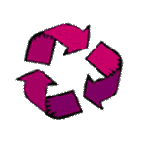"It's Only Waste if We Waste It!" Every act of consumption of raw materials requires a balancing 'input' or regeneration back to the Earth to be sustainable. In many ways humans are confused as to how best to give back to the Earth that supports us at this juncture in our existence. As we learn more about supporting natural processes it only makes sense to consume less raw products and reuse the ones already consumed. To the point it makes for a better economic flow……… a true beginning for Positive Quality Growth At LightEarth Consulting, we intercept reusable material as soon as possible after it enters the so-called "waste stream," and reuse or recycle it. These activities make ecological sense, obviously, but they also make economic sense: by reducing the waste stream, we extend the usable life of landfills, and help prevent unnecessary increases in the cost of land filling garbage. By buying fewer new products, we reduce the need for pollution-creating manufacturing processes, reduce dependence on foreign oil, and generally save money. LightEarth is always actively analyzing ways to reuse materials in the building and design process. One particular building is designed to utilize strictly 'throw away' materials. The width and breadth of what is available to reuse as a result of current building practices encourage us to demonstrate the viability of building with a different mindset. Estimates vary, but most waste management groups say that up to 20 per cent of the total wastes in our municipal solid waste stream is made up of construction and demolition debris. About 1/5 of this is from roofing scraps alone. A lot of this waste can be used again. A likely outcome of practicing reuse of building materials in this area will be the establishing of an outlet, ,to the public, for large scale transfer of useful materials. Facts
President Theodore Roosevelt's message may be the most enduring: "The nation behaves well if it treats its natural resources as assets which it must turn over to the next generation increased, and not impaired, in value."
|
Copyright - Light Earth Consulting - 2000
 "We
do not own the present. We borrow the present from our yet unborn
children. Think of at least ten future generations when making any
important decisions. We are after all, only caretakers here for a
fleeting moment of time." -Eric Straatsma
"We
do not own the present. We borrow the present from our yet unborn
children. Think of at least ten future generations when making any
important decisions. We are after all, only caretakers here for a
fleeting moment of time." -Eric Straatsma